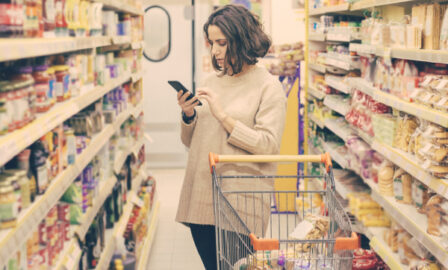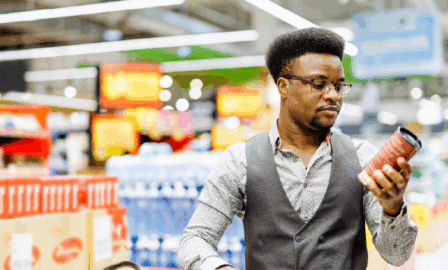Food Product Packaging Trends
Historically, the sole purpose of food product packaging was to protect items from contamination, minimize damage, and display mandatory Nutrition Facts. Over the years, however, food product packaging has evolved into an opportunity for product differentiation. This increased attention has resulted in food and beverage businesses ranking in the top three markets of global packaging sales.
Packaging is important for in-person purchases, but also for eCommerce transactions. The COVID-19 pandemic accelerated eCommerce-specific packaging trends and set compliance guidelines as well (i.e., Amazon’s Frustration Free Packaging). eCommerce-specific packaging formats include items like corrugated boxes, bags, and envelopes to ease delivery. Given its expanding impact, companies must consider how involved packaging is in their product offerings and how far their decisions reach.
CPG companies are seeing the value of packaging and the first impression it presents to customers. In both online and in-person outlets, the opportunity to communicate with consumers and potential consumers is invaluable. There are many ways companies are approaching food product packaging but below we highlight the most impactful trends that are aiding in the growth of packaging importance.
Top Food Product Packaging Trends
Smart Technology
Smart technology solutions, like QR codes, are added to product packaging to provide a more interactive experience. With a QR code, customers have a contactless experience with the company and learn more about the company’s background. Companies are also using QR codes to collect direct and rapid feedback from consumers, which they can then use to assist with product enhancement. For example, Nestlé uses QR codes on their Toll House Chocolate Chips to show the consumer the Nestle Baking 101 site and provide tips and tricks and recipes. This illustrates how the consumer’s experience is going beyond the consumption of the product but creating a relationship with the brand.
Customization & Personalization
Customization and personalization in packaging has expanded as companies try to make a deeper connection with customers. The Coca-Cola Company illustrates this idea through their “Share a Coke” campaign, which has people’s names printed on the bottle. This can generate a few extra seconds of customer engagement, and in 2018, Coca-Cola took it a step further by adding a peelable label and QR code to unlock prizes. By maximizing customer interaction and keeping them interested longer, companies glean more data and can discover a deeper understanding of their customers and brand.
Minimalism
Minimal and simple are often used as synonyms, but a minimalistic approach to packaging is quite difficult to perfect and anything but simple. Consumers want to see the food they are buying and learn about the company. By promoting a minimal and understandable ingredient list, and reducing clutter on the packaging, customers believe the company is being more transparent and trustworthy.
Talenti ice cream is an example of minimalism. Their packaging has black font and a clear container to show the product. This is literal transparency but also doubles as a showcase of the product through the use of the packaging.
Sustainability
From a consumer perspective, sustainability plays a significant role in purchasing decisions. One report shows that 61% of consumers state sustainability is an important criterion in their decision-making, and as a result, several companies have established sustainability plans for the next five to 10 years. One area heavily referenced in those sustainable strategies are packaging materials and alternatives such as recycled, biodegradable, compostable, and plant-based alternatives.
Beverage companies like Pepsi and Coca-Cola are commonly associated with setting and pursuing their sustainability goals. One major initiative is Coca-Cola’s goal of reducing their use of plastics and other materials by providing 25% of beverages in refillable or reusable containers by 2030. They are actively working on this pledge and recently announced Sprite’s bottle transformation from their classic green packaging to clear PET. This will enable more bottle-to-bottle recycling and increase the availability of multi-use packaging. In addition to Sprite’s changes, there are many other initiatives that beverage companies worldwide are leveraging to achieve their sustainability goals. Given that the US has a track record of high amounts of waste and low recycling, there is much room for improvement. However, companies must also be mindful to avoid greenwashing with these initiatives.
While some companies are rethinking their current packaging, others established their company’s values and mission through their sustainable packaging. Boxed Water is an excellent example of rethinking the status quo and tying a company’s values to packaging. They utilize paper-based cartons, which are 92% renewable rather than using plastic or aluminum, further embracing their mission of providing a sustainable alternative to plastic bottles with the paper cartons being refillable. Additionally, with a simple and sleek design, their packaging is minimalistic and helps their carton stand out even more.
The Future of Food Product Packaging
Food packaging is continuously developing, with emerging trends focused to meet the ever-changing needs of the consumers. Thus, to be successful, companies must be agile and make decisions swiftly and with confidence. Below, we touch on a few budding trends that should be on your radar for the future.
Convenience
Consumers are constantly on the move and looking for convenience in every aspect of their lives. With products like squeezy applesauce pouches and yogurt tubes, packaging is focusing innovation on portability, individuality, (i.e., ice coffee cans, detergent pods, microwave ready oatmeal cups, etc.) and re-sealability (i.e., nuts, fresh/frozen fruits & vegetables, etc.). Even though many products are seen as convenient, companies are continuing to develop packaging to fit the multiple purchasing methods (grocery stores, online, drive-thrus, vending machines, etc.) to fit the busy consumer lifestyle.
Edibility
To help alleviate food waste, edible packaging is gaining traction in the industry. It has dual purposes and can be used for consumption and sustainability. While it is heavily dependent on the type of product and flavor profile, more consumers are becoming accepting of it. According to PackFactory, “edible packaging is made from plant based materials that are natural and biodegradable.” For instance, edible straws and silverware from natural ingredients are fulfilling both convenience and sustainability.
Food Spoilage Detection
“Sell by” and “best by” dates can be confusing to customers trying to identify the actual expiration date of a product, resulting in food waste and food safety issues. This problem is confirmed by the CDC’s annual estimate of 48 million people in the U.S. who get sick because of spoiled food. Thus, an easier way to identify food safety risks can be impactful for consumers and waste reduction.
To assist with easing the process of identifying spoilage, color changing packaging has evolved to show when food has gone bad. This is done with materials that detect changes in various chemical indicators like pH. Testing is underway with a multitude of products, such as milk, but incorporating the technology and scaling is in its early phases.
When creating or updating products, it’s important that packaging needs and trends are considered. With consumers more heavily relying on packaging to make purchasing decisions in addition to packaging expenses raising, there are many criteria to take into consideration. Developing the best strategy for your company is key since this builds brand awareness, encourages consumer engagement, and promotes loyalty. Thus, with more companies investing in packaging improvements, it’s critical that brand strategies include everything – from the product to the package!
Subscribe to Clarkston's Insights
Contributions from Addie Schmidt



